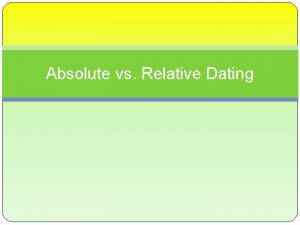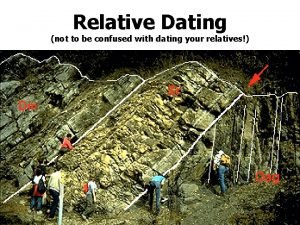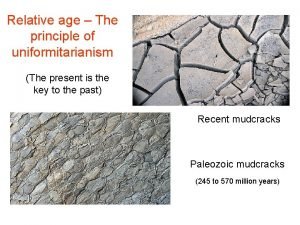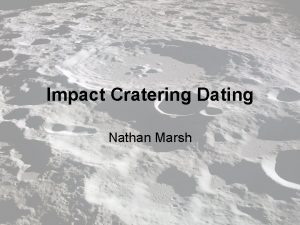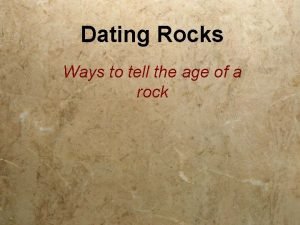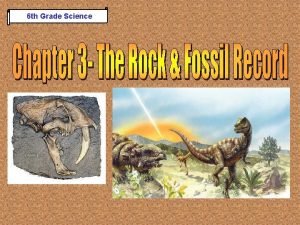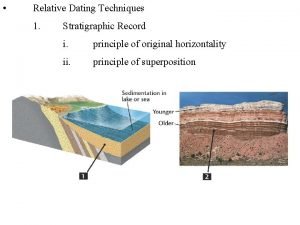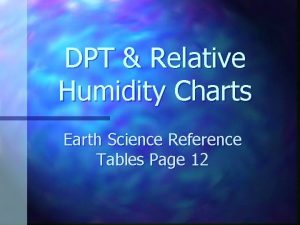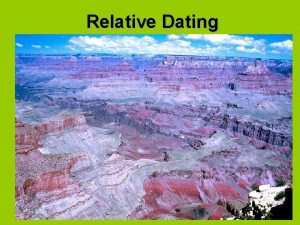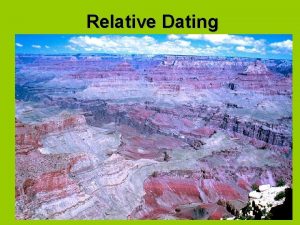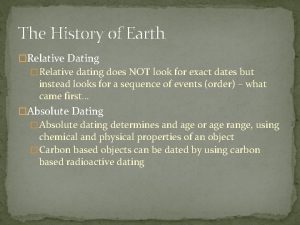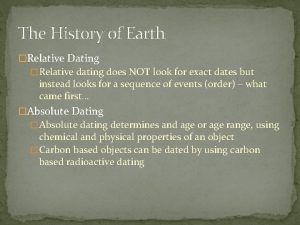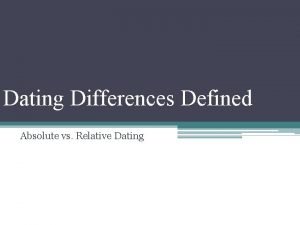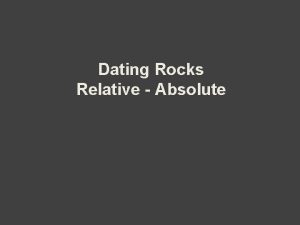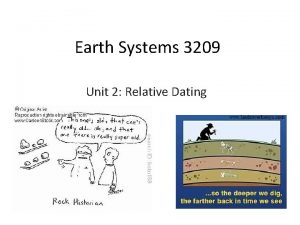The History of Earth Relative Dating Relative dating













- Slides: 13

The History of Earth �Relative Dating � Relative dating does NOT look for exact dates but instead looks for a sequence of events (order) – what came first… �Absolute Dating � Absolute dating determines and age or age range, using chemical and physical properties of an object � Carbon based objects can be dated by using carbon based radioactive dating

Absolute Dating : A Measure of Time Earth Science 8. 2

Objectives: Describe how radioactive decay occurs. 2. Explain how radioactive decay relates to radiometric dating. 3. Identify four types of radiometric dating. 4. Determine the best type of radiometric dating to use to date an object. 1.

Radioactive Decay �Absolute dating � Measuring the age of an event or object in years. �Methods to determine the absolute ages of fossils and rocks � Rate of Erosion � Rate of Deposition � Varve Count � Radiometric Dating � Carbon Dating

Rate of Erosion Rate of Deposition �Determine how fast the �Determine age by area has been eroded �Reliable for features less than 10, 000 years old �Unreliable for older than 10 K years old because the rate of erosion can be varied over millions of years amount of material deposited �Not accurate only an estimate �Deposits can vary based on natural events (floods)

Varve �Similar to counting rings on a tree (dendrochronology) �Varves are band of light coarse material & band of dark fine material � Example: Winter can break down (weather) carry (erode) and deposit (deposition) coarse sedimentary rock which settles on the bottom of an area, then summer might bring the fine material. This will repeat and build over thousands of years. One band of light and dark material is a varve.

Radiometric Dating �Using Radioactive decay to find out the age of material � Rocks contain small amounts of radioactive material � Energy is released the atoms change into different isotopes � Scientists measure the concentration of the original isotope (parent) and the newly formed isotope (daughter)… � WHATS going on? !? !? !?

Radiometric Dating – from the top �Most isotopes are stable, meaning that they stay in their original form. �Other isotopes are unstable. � Scientists call unstable isotopes radioactive. �Radioactive decay � Radioactive isotopes tend to break down into stable isotopes of the same or other elements. Isotopes atoms of the same element that have the same number of protons but different numbers of neutrons.

�Because radioactive decay occurs at a steady rate, � Scientists can use the relative amounts of stable and unstable isotopes present in an object to determine the object’s age. �Dating Rocks — How Does It Work? � In radioactive decay, an unstable radioactive isotope of one element breaks down into a stable isotope. � The stable isotope may be of the same element or of a different element. �Parent isotope � The unstable radioactive isotope. �Daughter isotope � The stable isotope produced by the radioactive decay of the parent isotope.

�The rate of radioactive decay is constant � so scientists can compare the amount of parent material with the amount of daughter material to date rock. �The more daughter material there is � the older the rock is.

Radiometric Dating �Radiometric dating � Determining the absolute age of a sample, based on the ratio of parent material to daughter material. �If you know the rate of decay for a radioactive element in a rock � you can figure out the absolute age of the rock. �Half-life � the time needed for half of a sample of a radioactive substance to undergo radioactive decay. �After every half-life, the amount of parent material decrease by one-half.

Types of Radiometric Dating � Scientists use different radiometric-dating methods based on the estimated age of an object. �There are four radiometric-dating techniques. 1. Potassium-Argon Method � Potassium-40 has a half-life of 1. 3 billion years, and it decays leaving a daughter material of argon. � This method is used mainly to date rocks older than 100, 000 years. 2. Uranium-Lead Method � Uranium-238 is a radioactive isotope with a half-life of 4. 5 billion years. Uranium-238 decays in a series of steps to lead-206. � The uranium-lead method can be used to date rocks more than 10 million years old.

3. Rubidium-Strontium Method � The unstable parent isotope rubidium-87 forms a stable daughter isotope strontium-87. � The half-life of rubidium-87 is 49 billion years � This method is used for rocks older than 10 million years. 4. Carbon-14 Method � Carbon is normally found in three forms, the stable isotopes carbon-12 and carbon-13, and the radioactive isotope carbon-14. � Living plants and animals contain a constant ratio of carbon-14 to carbon-12. � � Once a plant or animal dies, no new carbon is taken in. The amount of carbon-14 begins to decrease as the plant or animal decays. The half-life of carbon-14 is 5, 730 years. The carbon-14 method of radiometric dating is used mainly for dating things that lived within the last 50, 000 years.
 Dating serves several important functions that include:
Dating serves several important functions that include: Relative dating rock layers
Relative dating rock layers Relative dating
Relative dating Relative age
Relative age Geopuzzle
Geopuzzle Relative age of rocks diagram
Relative age of rocks diagram Relative dating
Relative dating Dating
Dating Relative dating
Relative dating Discomformities
Discomformities Features of phacops and tropites as index fossils
Features of phacops and tropites as index fossils Law superposition
Law superposition Earth science reference table dew point
Earth science reference table dew point Hát kết hợp bộ gõ cơ thể
Hát kết hợp bộ gõ cơ thể

